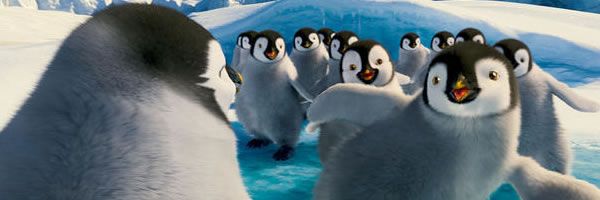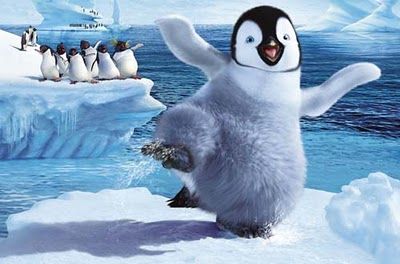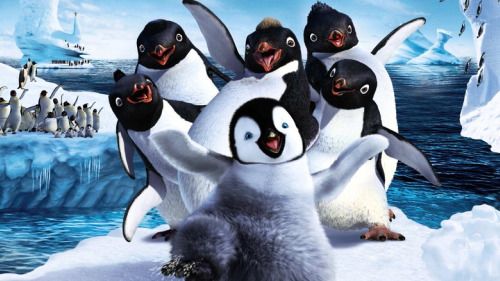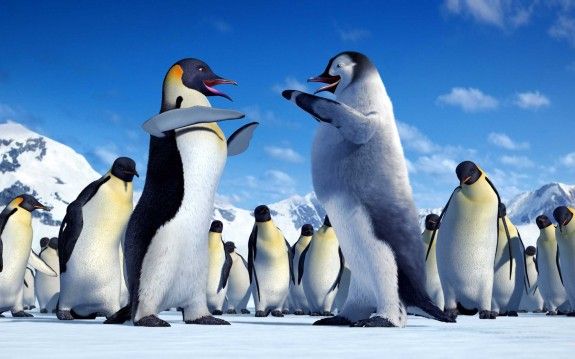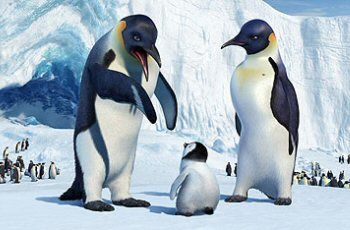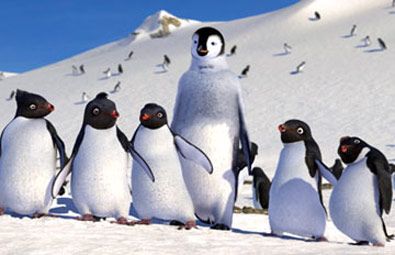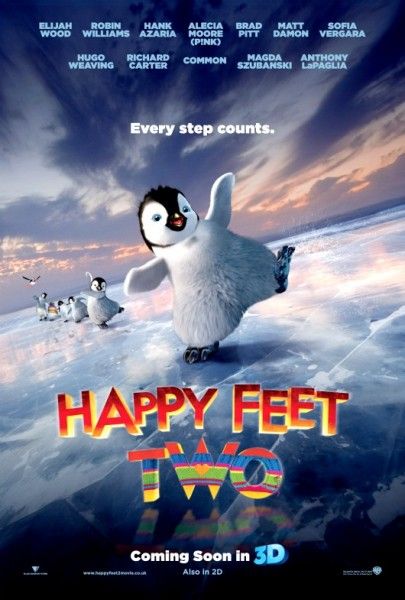The adorable singing and dancing penguins of Antarctica are back for Happy Feet Two. In the 3D animated feature, Erik, the tiny son of master tap dancer Mumble (voiced by Elijah Wood) and the vocally gifted Gloria (voiced by Pink), runs away and encounters The Mighty Sven (Hank Azaria), the only penguin who can fly. When violent shifts in the glacial landscape threaten the survival of the entire Emperor penguin community, Mumble and Erik must rally all creatures, both great and small, to save them.
During a press conference to discuss the film, voice actors Elijah Wood, Robin Williams (who voices both Ramon and Lovelace), Hank Azaria and Common (who makes his animation debut as Seymour) talked about the joy of getting to work together for the recording process, developing the voice they wanted to use for their characters, and being able to improvise and bounce things off each other. Check out what they had to say after the jump:
Question: Can you guys compare this experience with your other experiences, in doing animated films?
HANK AZARIA: This was the most soulful animation experience I’ve ever had. We all recorded together, and we all went to Australia to record together. Not only did that free us up to improvise and bounce off each other a lot, but it became a very intense character exploration. It was one of the most gratifying creative experiences I’ve ever had, in any medium. I really, really enjoyed it.
ROBIN WILLIAMS: We got to work together in the same room, and I forgot that when I did other animated films, I was alone most of the time. With Aladdin, it didn’t matter because I was creating 40 different voices. But with this, it was so great to have everybody in the room together. You build a rhythm. The wonderful thing about all of it was that (writer/director) George Miller was watching it.
ELIJAH WOOD: Going to Australia, this time around, made the experience more immersive. We weren’t in Los Angeles, going home at night to our own homes. We were all staying in the same hotel and it was more of a collective, immersive experience. I loved that about it.
COMMON: For me, this was my first film where I got to do voice-over work for an animated character. It was an incredible experience. I was so looking forward to working with George Miller because I just love his creativity. Being able to improvise and be creative, in that creative space, definitely provided me with one of the best creative experiences that I have ever been it. It was a great way for me to start my voice-over, animated acting career. I had a great time. Plus, I got to bring the musical element to it. George wanted my character, Seymour, to be soulful and have a certain essence. I was like, “Man, this really has heart to it. This has meaning to it.” It was really great for me to get into it and use my imagination, in a way that you’re able to when you’re doing this type of work. It was very new for me, and refreshing.
Robin, was it fun to work with Sofia Vergara, as your character’s love interest?
WILLIAMS: Yeah, that doesn’t suck. I was like, “Yeah!”
WOOD: I was lucky enough to overlap one day with her. It was a joy.
WILLIAMS: It was actually 3D, in the room.
Robin, can you talk about the love story with Ramon and Carmen? Do you think that love is the most important thing there is?
WILLIAMS: It’s pretty close to it. It’s cheaper than Prozac. Ramon is a hopeless romantic, in that way. He’s this little guy who wants love in the worst way, which is usually in person. He even takes rejection as acceptance. He’s like, “Fat chance? I’ve got a chance! And it’s fat!” He’s more than smitten with Carmen, he’s bitten, and it’s off and running. With this, at least he does get the girl. He takes a leap of faith, literally. His love story is quite lovely because, most of the time, he doesn’t get the girl.
Robin, what does it feel like, to have just turned 60?
WILLIAMS: Sixty is pretty amazing. I had a mid-life crisis at 40, so this is pretty sweet. Sixty is wonderful. I’m like, “I’m alive!” It’s great. Once I had the heart surgery, it’s me, 2.0. And, I have a cow valve, which means I can shit standing up now. It’s pretty sweet. And, I’m just off my honeymoon, which at 60 was wonderful. I actually remember it. And, a honeymoon in Paris doesn’t suck either.
How did you go about developing the voice you wanted to use for your character?
AZARIA: I worked with a vocal coach. I like to do that, when it’s an accent. Scandinavian was a new one, on me. We worked to make it really meticulous and get an authentic Scandinavian accent. And that, we realized that it was funnier, in many places, to have a bad Scandinavian accent, so we went in and out.
WILLIAMS: For Ramon, George said, “Make him an Argentinian football player.” Recently, I had a Hispanic woman come up to me and say, “You know, your accent is very Cuban.” I wanted to make him small, but fierce, much like myself. And then, with Lovelace, I combined a little bit of Foghorn Leghorn and Barry White. Plus, when I grew up in Detroit, there were all these Baptist ministers that you would hear on the radio, or sometimes on TV. I gave him that kind of power. It was easy to separate the two characters.
WOOD: I just had my own voice, really. This time around, the register was a little bit lower because he’s older. That was the only major difference .
COMMON: I wanted to bring a new voice, but most of the time, George wanted me to stay in my voice. For some reason, when I hear it now, it doesn’t totally sound like me, so I’m happy about that. I love just being a character.
For those of you who are dads, did you ever have to compete with a charismatic person in your child’s life?
WILLIAMS: I once was reading a story to my daughter, Zelda, when she was three. I was reading the story in different voices and, all of a sudden, she went, “Don’t do the voices. Just read the story.” I was like, “Oh, okay, great. Thank you, missy.” It isn’t threatening to me, if they’re inspired by someone. That’s kind of wonderful. I was lucky enough to have teachers or coaches that inspired me and took me to the next level. It’s not threatening. It’s just a joy to know that there are other people in their lives that are giving them the spark.
COMMON: I have a daughter who’s 14 years old. Being that I’m a musical artist too, she definitely loves what I do, but she always brings up other artists and says they’re getting a little better than me now. That definitely lessens the presents that she gets now. But overall, she’s just trying to keep me sharp and keep me on point, so I’m cool with it.
Robin and Hank, since you have considerable experience doing animation work, in a booth by yourself, what was it like to work with the cast for this? Was there any moving around going on?
AZARIA: In my cranky old age, I actually prefer recording alone now, on The Simpsons, for example, because I find that the director can just focus on what I’m doing and I can do a lot of variations. A lot of times, when I record with a group, I’ll stay after class for another hour or two and go, “Let me try a bunch of things I was thinking of, as you were doing that.” I wasn’t reluctant to do it. I’ve also done a lot of recording together, and that can be more fun. But, I had no idea how much the community of us being together would make a tremendous difference. Not only was it fun, and a very warm, fantastic experience, but we were exploring the characters together, as we were doing it. I was really just trying to find my character. I’ve done theater experiences, where you’re obviously with each other, that have been less united and less of a gratifying experience. That’s George [Miller]. The environment that he set was extraordinary. A lot of the work was very emotional. It wasn’t just funny. And, both for the improvising and the emotional stuff, it was a tremendously supportive, creative environment. I’ve never experienced that before, in any other situation, honestly. Also, we did so many takes and explored so much. There were two people there, just in charge of keeping track of what was going on in each take, so they could somehow find it again later. Especially with Robin [Williams], you need to keep track of what’s going on. It was fantastic. It really was extraordinary.
WILLIAMS: You do end up moving around because you do get excited, working together. You’d sweat through stuff. At the end of the day, I’d go, “I’m just doing a voice, but I’ve sweated through a shirt.” But, because of the activity and moving off each other, you just build a rhythm. It’s like an old radio play. We would always break away and start to work together. That was because of [George Miller].
AZARIA: I had never done that before. A few times, we’d be recording across the room from each other, and then decide to get on the same mic and be close, at George’s suggestion. I was exciting when I got to work with Pink. I’m actually not joking. That was a first for me. You have to always physicalize, when you do animation recording. Otherwise, you won’t get the performance right. But, that was unique.
WOOD: Sometimes, George would grab ahold of me. I had to react to something physically, and he was down there, grabbing onto my leg for a reaction. Sometimes we would get on the floor to record things. It was incredibly physical. For some of the emotional bits, I remember sharing a mic. I think E.G. Daily and I shared a mic for a scene with an emotional moment, and that was beautiful. It really went far and above the standard recording process. It was very immersive.
Common, what was it like to create the personality for Seymour and get to do the musical numbers?
COMMON: From what I got from George, Seymour is somebody who has compassion and is a leader, in his own right. He is a fatherly penguin, but he’s cool too. He has something cool about him, and is about the community. I felt, to the core, that that’s some of the elements of who I am, in many ways, and I felt that I could bring that essence to Seymour. Along with that, just being able to bring hip-hop to it was really cool for me because George allowed us to do improvisation for different things that would come about from the other actors that I was working with. Everybody was bringing something, and it just allowed us to go forward with it. And then, if George heard something that he liked, he would say, “Yeah, that’s it. That’s it, right there. Stay with that.” It was really like being in a freestyle session, to a certain extent. You could improv and come up with great songs and riffs, and different things like that. When I got to know what a lot of the music was going to be, I was really overwhelmed. I loved how the music had a universal tone to it. No matter what walk of life you’re from, you can appreciate the music. Even if you don’t know a particular song, these songs resonate in your soul and your heart, and they really express the universal appeal of the film and what the story is about. It relates to so many walks of life. I love being able to be a part of that type of music. As an artist, that’s the type of music I want to create. It was great to be a part of this.

